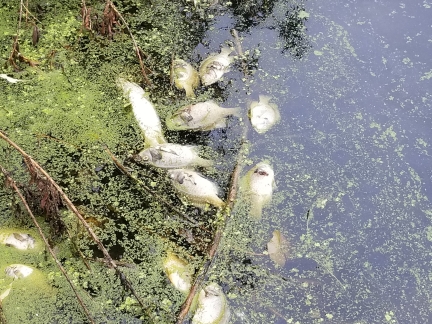
While hundreds of fish kills occur in Minnesota every year, mostly in lakes and ponds, fish kills on trout streams in southeast Minnesota are much less common. The cause of most lake/pond fish kills is believed to be from natural causes such as disease or low oxygen levels under ice. These natural causes, however, may be exacerbated by chronic environmental conditions such as excess nutrients in lakes, and extreme weather.
In trout streams, fish kills are usually related to the discharge or runoff of pollutants from the landscape through incidents like toxic spills, runoff of manure, pesticides, or fertilizers, and high-temperature wastewater or stormwater discharges.
Tips for farms
Agriculture is an essential part of Minnesota and our rural communities. Farmers feed us, fuel our cars, and drive our economy — all through long days and a short growing season. Windows for applying manure, fertilizer, and pesticides can be short, making application timing difficult.
Smart application of manure, pesticides and fertilizers is critical to maximize their nutrient value and increase crop productivity. Runoff from fields not only reduces crop productivity but may impact water quality and could contribute to fish kills, especially when improperly applied or applied too close to rain events.
Application tips to reduce runoff:
- Forecast: Avoid any applications when rain is forecast. Use caution when applying to saturated soil. The Minnesota Department of Agriculture’s Runoff Risk Advisory Forecast tool can help determine the best time to apply.
- Location: Observe all applicable setbacks to surface waters and sensitive areas. Pay special attention to areas of your fields where water flows after rain or snow melt. Stay clear of steep slopes and surface water locations, such as rivers, streams, or sinkholes and wetlands.
- Rate: Follow labels to ensure proper application rate. Use the University of Minnesota Extension’s manure management website to calculate the best rates for your fields.
- Method: Reduce nutrient loss by selecting the best application method for your manure and chemicals and incorporate them into the soil immediately to decrease evaporation and runoff.
Learn more about best management practices for land application of manure.
Tips for homes and yards
Many actions that increase the state’s resiliency to climate change can also help protect fish and other aquatic life, including:
- Avoid putting down lawn chemicals before a heavy rain.
- Keep grass clippings out of streets and roads where they will clog up storm drains.
- Keep your septic systems operating properly and dispose of your household waste correctly.
- Use a rain barrel to reduce roof runoff.
- Plant trees or deep-rooted native plants to slow, trap, or reduce pollutants that leave the land and flow to waterways during intense rain events.
Drinking water
Runoff doesn’t just impact fish. It may impact drinking water in private and community wells. Some geographic land features can quickly deliver pollutants to groundwater through sinkholes and fractured bedrock. In southeast Minnesota, for example, the cracks and gaps between rocks in the earth’s surface called karst make groundwater more susceptible to pollution. Learn more about well testing at the Minnesota Department of Health’s website.
Extreme weather and climate change
Minnesota’s weather is changing: We’re getting warmer and wetter. Strong storms following long dry periods can increase the risk for fish kills in streams. These weather transitions from extreme wet to dry are also happening more quickly and more frequently, making the timing of any applications that much more critical. Rains can wash away valuable nutrients and pollute downstream waters. Increased water temperatures stress cold water fish species and this stress magnifies when combined with other factors.
- Slow soaking rains typically allow nutrients and chemicals to be absorbed by fields and yards. Intense storms can “sweep fields clean” of anything that’s been recently applied, washing it all downstream.
- Low flow streams due to hot dry periods are more dramatically impacted by polluted runoff since there isn’t enough water to dilute any pollution entering the waterway during a runoff event.
This extreme and unpredictable weather makes land management more difficult for farmers and landowners.
Response and investigation
The MPCA, Department of Natural Resources (DNR), Department of Agriculture (MDA), and Department of Health (MDH) coordinate on fish kill responses. Agency program staff coordinate and triage fish kill reports to determine the appropriate level of response and investigation for each. The DNR makes initial assessments regarding reports that indicate likely winterkill or summerkill. When a fish kill presents a threat to public health and safety, MDH will get involved. The MDA takes the lead for pesticide and fertilizer incidents while the MPCA investigates the environmental impacts from the release of hazardous materials, oil, or other materials such as manure. Local governments also help with fish kill investigations.
State and county specialists in water quality, watershed management, feedlots, fisheries, and laboratory analyses all work together to explore possible causes of fish kills.
If responding agencies believe a fish kill resulted from natural causes, then investigation and follow-up action will be limited.
Some fish kills have obvious causes, such as a spill or identifiable discharge to a surface water. One example is when a tanker truck tips over in a ditch, spilling a product toxic to fish that flows to a stream. Other fish kills have less discernible causes that are often driven by rain events somewhere in a watershed. An example would be an intense rain event that creates runoff to streams from many agricultural fields and city streets in a large upstream watershed. Finding a clear explanation for a fish kill will depend largely on the lag time between the kill and its reporting, as well as the complexity and scope of the cause(s).
